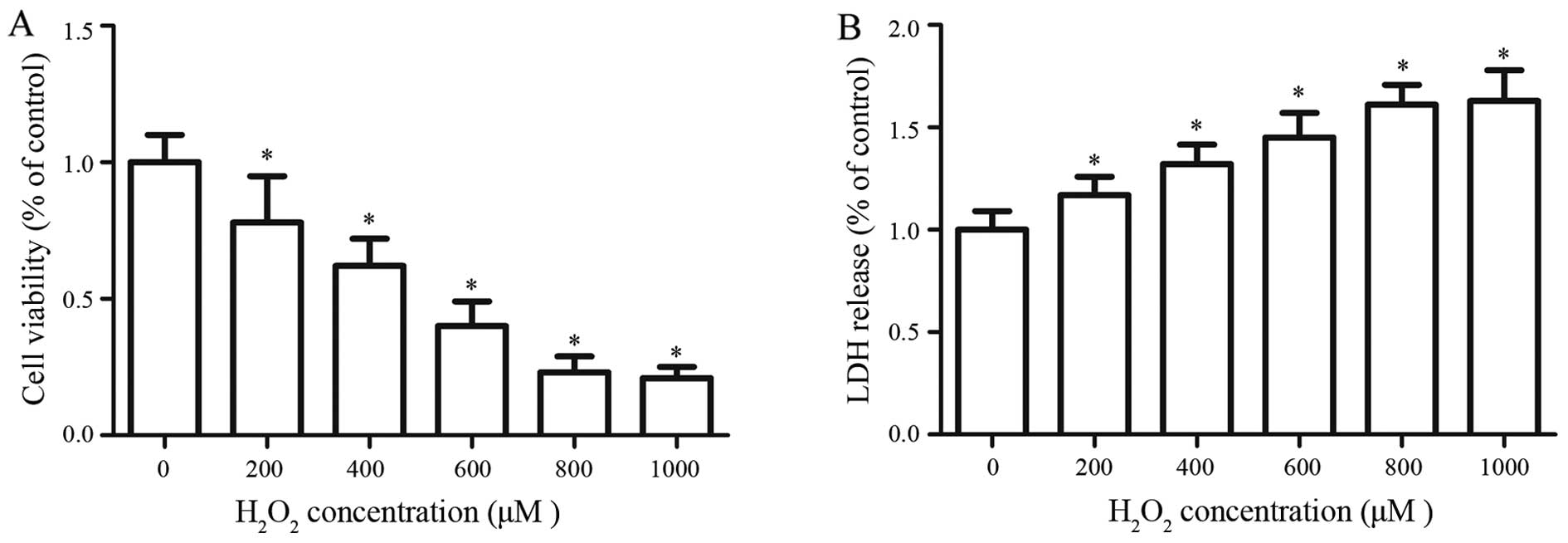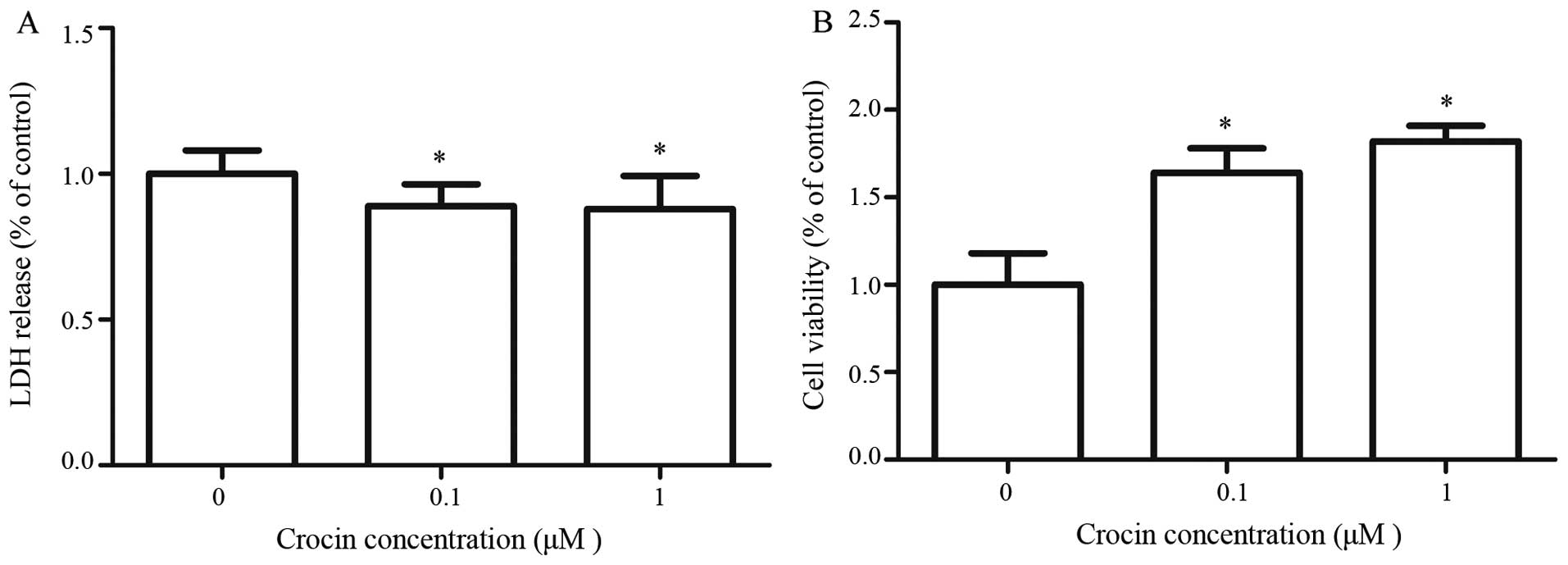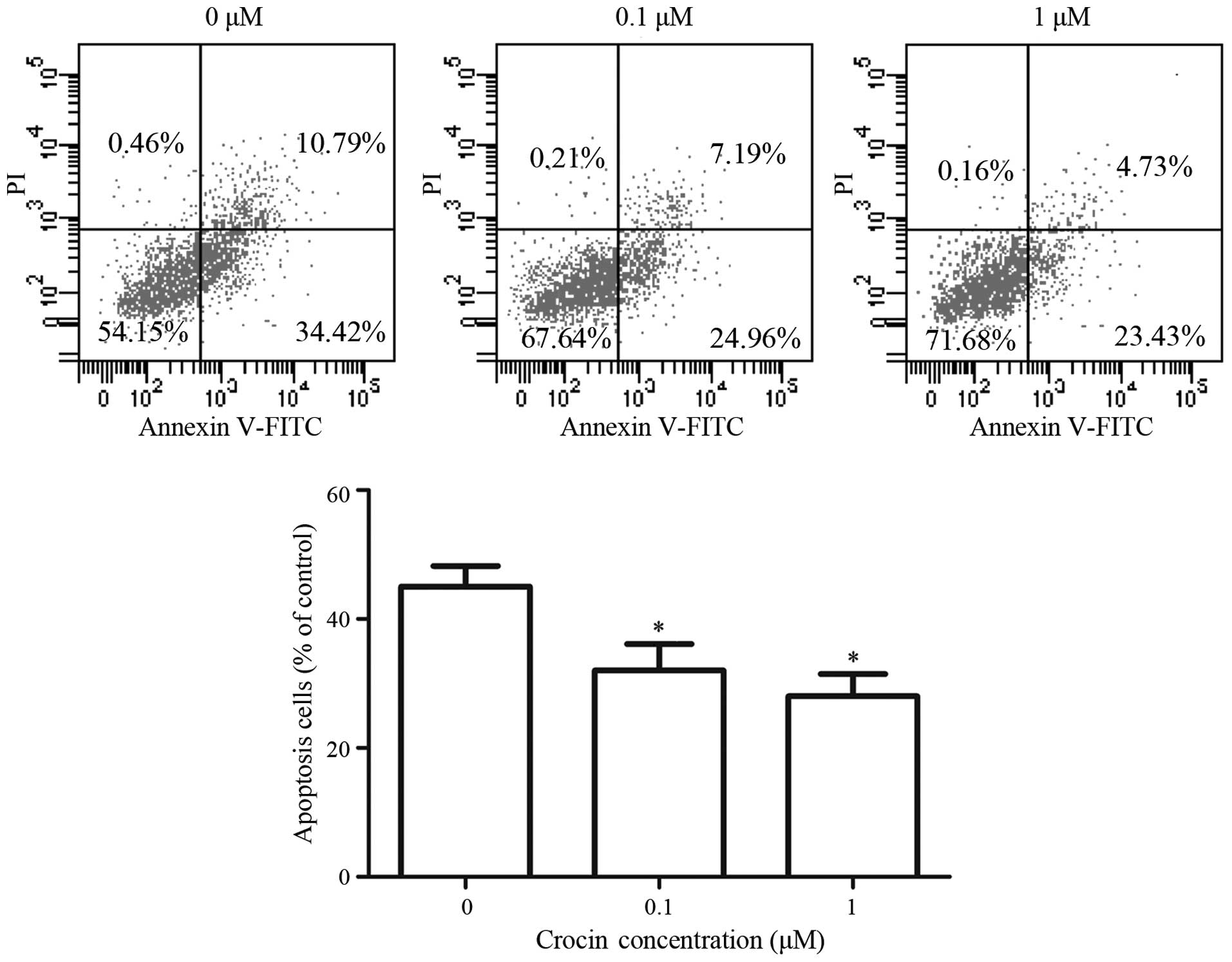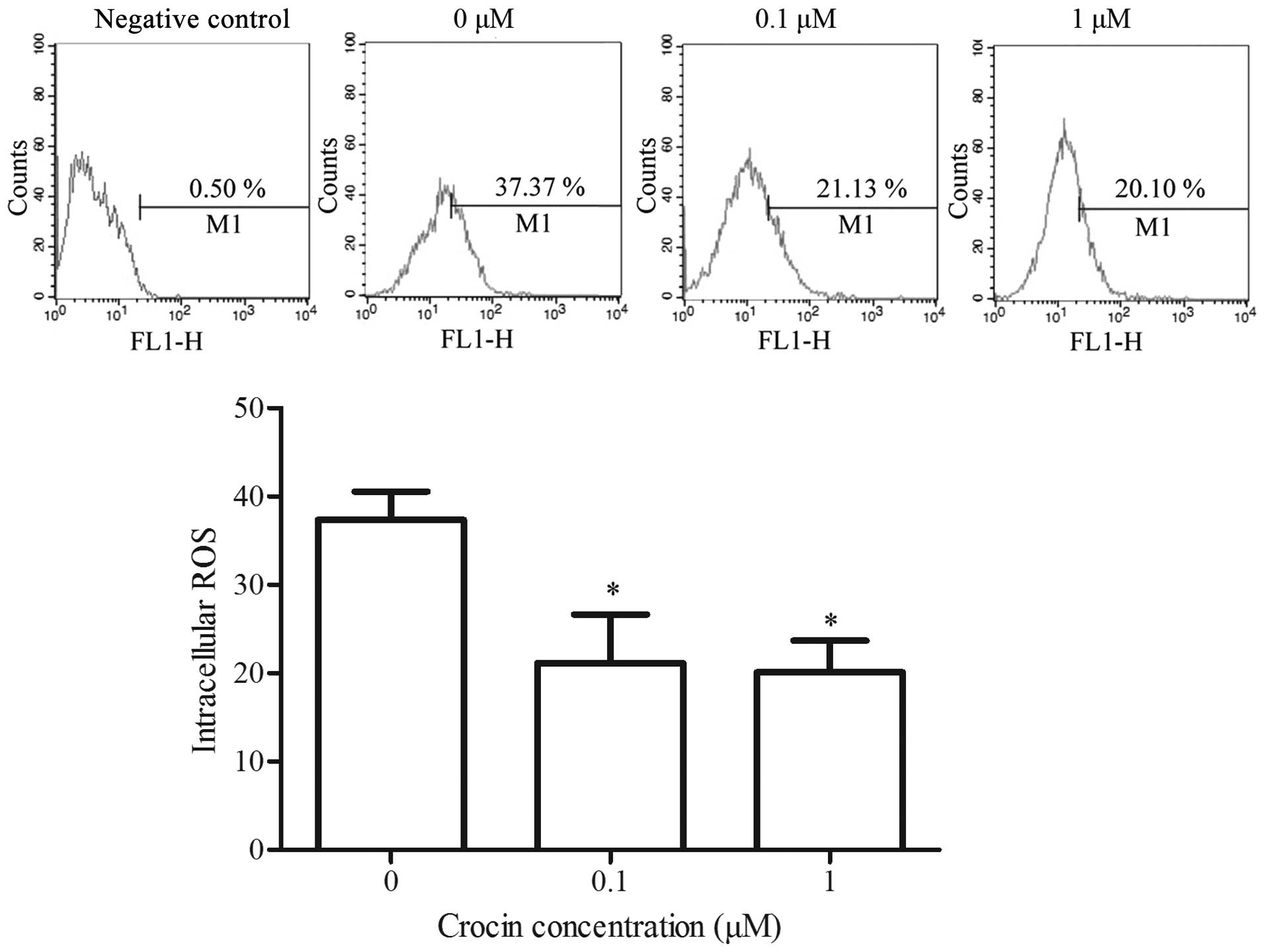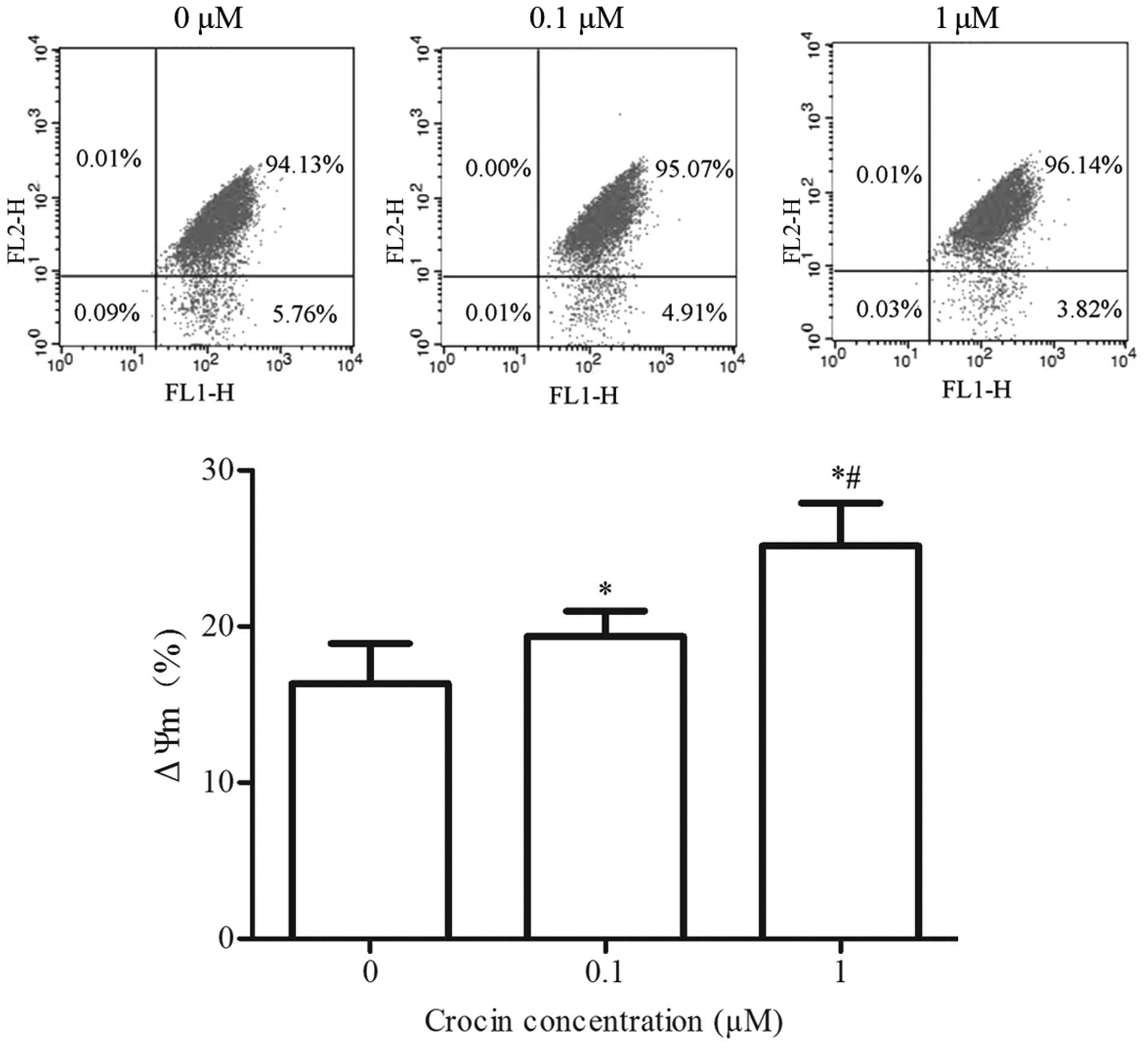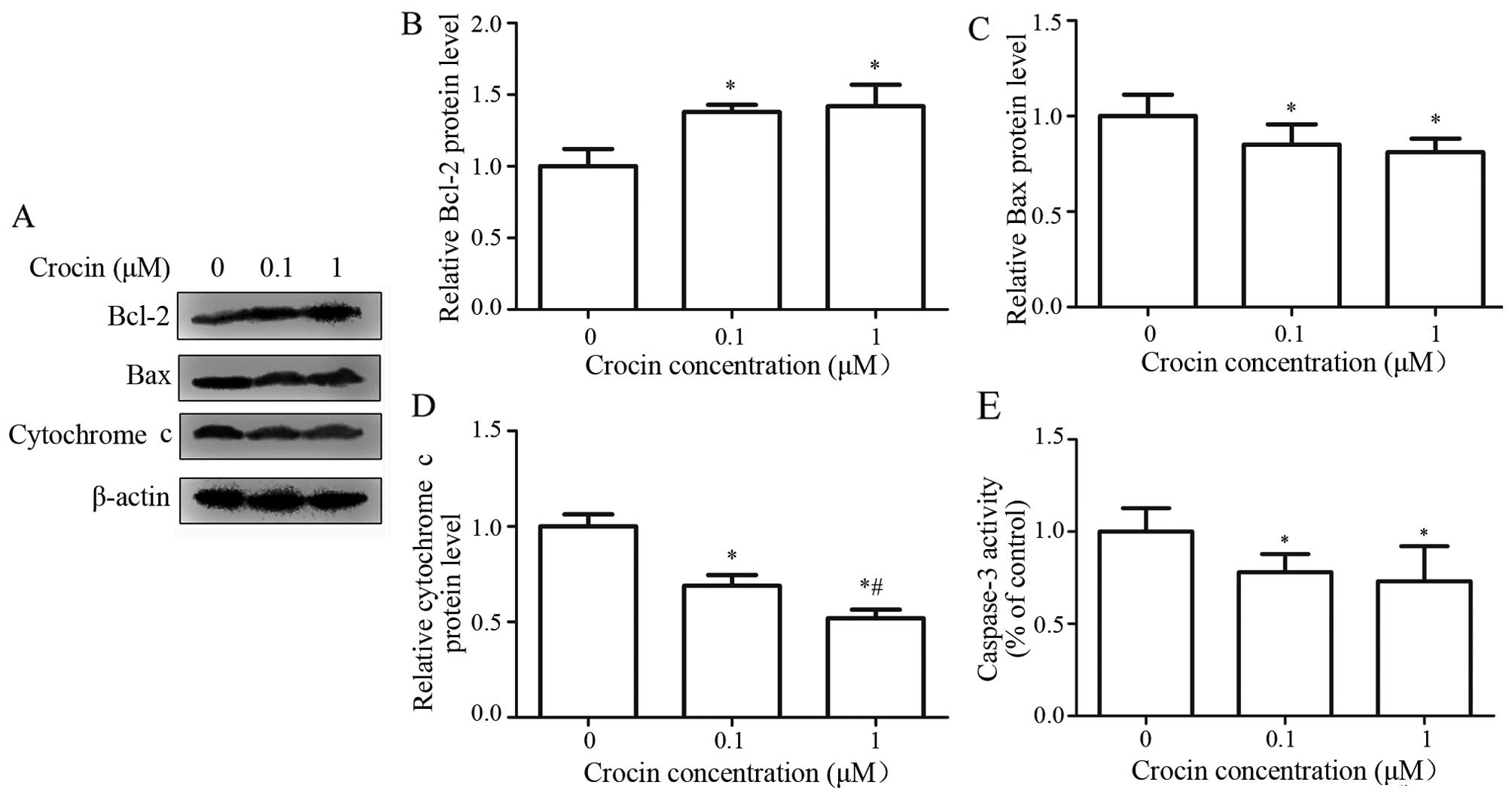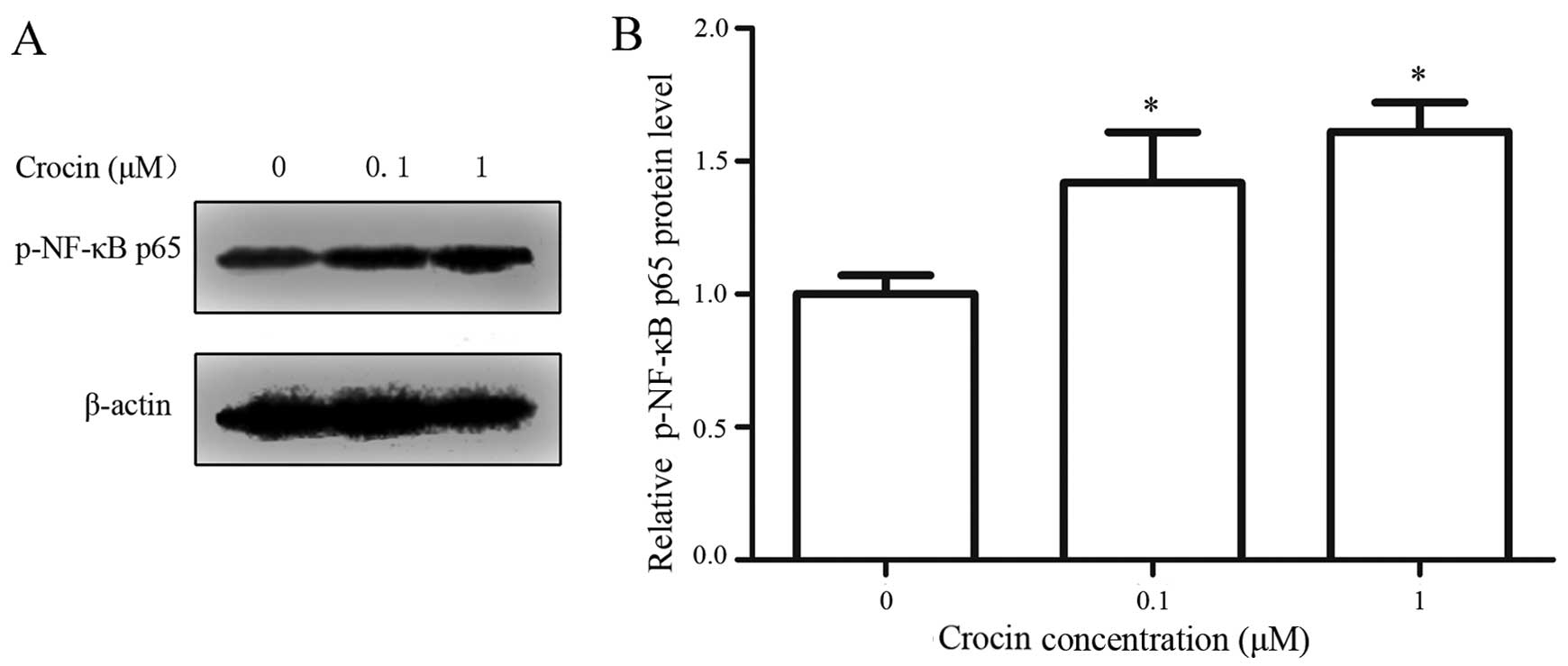Crocin protects retinal ganglion cells against H2O2-induced damage through the mitochondrial pathway and activation of NF-κB
- Authors:
- Published online on: November 23, 2015 https://doi.org/10.3892/ijmm.2015.2418
- Pages: 225-232
Abstract
Introduction
Glaucoma is a degenerative nerve disorder, which is characterized by optic atrophy and visual field defects, and results in irreversible blindness. It has been reported that almost 64.3 million patients suffered from glaucoma worldwide in 2013, and this number is likely to increase to 76 million in 2020 and 111.8 million in 2040 (1). The hallmark of glaucoma is the apoptosis of retinal ganglion cells (RGCs), which are the only efferent neurons that convey visual signals from the retina to the brain. Several risk factors, including elevated intraocular pressure (2), oxidative stress (3), elevated glutamate (4) and aging (5), have been considered to accelerate RGC apoptosis in glaucoma, among which, oxidative stress is considered as the final common pathway in glaucoma (6). Several studies have reported that oxidative stress can lead to apoptosis of RGCs through activation of the mitochondrial pathway (7), and that apoptosis is the main cause of RGC loss (8). Thus, identifying a way of inhibiting oxidative stress-induced apoptosis in RGCs may provide an effective therapy for glaucoma.
Oxidative stress is able to destroy mitochondrial membrane potential (ΔΨm), induce mitochondrial DNA damage and the release of apoptosis-related factors, and thus, trigger apoptosis (9). Mitochondria play an important role in the functioning and survival of RGCs (10,11), and mitochondrial dysfunction has been observed in glaucoma patients (12). Mitochondrial dysfunction is regarded as an early event in the mitochondrial apoptotic pathway. In the mitochondrial apoptotic pathway, mitochondrial dysfunction and the activation of pro-apoptotic Bcl-2 family members has been demonstrated to induce the release of cytochrome c, which forms the apoptosome complexes, and contributes to the activation of caspase-9 and the cleavage of caspase-3 (8,13,14). The mitochondrial-dependent apoptosis of RGCs has been previously investigated (15). As an important consequence of mitochondrial dysfunction caused by oxidative stress, excessive reactive oxygen species (ROS) are capable of mediating mitochondrial permeability transition and the release of pro-apoptotic proteins, and thus, stimulate the mitochondrial apoptotic pathway (9).
Saffron is a traditional medicine that is frequently used in clinical therapy. The clinical therapeutic effects of saffron have been demonstrated in cancer (16), hypertension (17), insomnia and anxiety (18), cerebral ischemia (19) and depression (20). The effect of saffron on retinal diseases has also been demonstrated by improving focal macular electrorectinogram parameters (21), inhibiting cell death induced by intense light (22), and treating macula lutea and ischemic retinopathy caused by old age (23). Crocetin and crocin are the two major active ingredients of saffron. Crocetin can is capable of preventing the retinal damage induced by oxidative and endoplasmic reticulum stresses through inhibition of the activity of caspase-3 and -9 (24), and of protecting the retina from ischemic damage via the inhibition of oxidative stress (25). Crocin has also been shown to exert a protective effect on retinal ischemia/reperfusion (IR) injury-induced apoptosis of RGCs (26). However, the mechanism by which crocin protects against oxidative stress-induced damage toof RGCs remains unclear.
In the present study, we investigated the protective effects of crocin on RGCs under oxidative stress. Hydrogen peroxide (H2O2) was used to establish a model of oxidative stress injury in RGCs to mimic RGC injury in glaucoma in vitro. The anti-apoptotic effect of crocin was determined, and the mitochondrial-mediated apoptosis pathway was examined to determine the anti-apoptotic mechanism of crocin. In addition, the activity of phosphorylated nuclear factor-κB (p-NF-κB) p65 was also measured using western blot analysis.
Materials and methods
Cell culture
RGC-5 cells, obtained from the American Type Culture Collection (Cat. no. PT6600; ATCC, Manassas, VA, USA), were cultured in Dulbecco's modified Eagle's medium (DMEM) supplemented with 10% fetal bovine serum (FBS) (both from Gibco, Carlsbad, CA, USA), 100 U/ml penicillin and 100 μg/ml streptomycin (both from Sigma-Aldrich, St. Louis, MO, USA). Cells were grown in a humidified incubator with 5% CO2 at 37°C and passaged every three days. Second generation RGCs were used in our experiments.
Establishment of a model of oxidative stress injury in RGCs and crocin treatment
The cells were equally divided into five groups, which were treated with different concentrations of H2O2 (0, 200, 400, 800 and 1,000 μM) for 16 h. Cell viability and lactic dehydrogenase (LDH) release were tested to investigate the cell injury induced by H2O2 in RGCs, and an appropriate concentration was chosen to establish the model of oxidative stress injury in RGCs.
RGC-5 cells were pre-treated with 0.1 and 1 μM of crocin (Sigma-Aldrich) for 24 h, and no drugs were added to the control group. The cells were then subjected to oxidative insult with H2O2 (800 μM) for 16 h and collected for subsequent experiments.
WST-1 cell proliferation assay
Cell viability was determined using a WST-1 assay (Roche Diagnostics GmbH, Mannheim, Germany). Briefly, the cells were cultured as described above. WST-1 reagent (10 μl) was then added to each well, and incubated for 4 h at 37°C. The optical density (OD) was read at 440 nm using a microplate reader (FLUOstar Omega, BMG Labtech, Ortenberg, Germany).
LDH release assay
LDH release was determined using a LDH cytotoxicity detection kit (Takara Bio, Tokyo, Japan). Briefly, the cells were cultured in 96-well plates and 100 μl cell suspensions of RGCs were collected to assess the LDH activity. Fresh reaction mixture (100 μl) was then added to each well and incubated at room temperature for 30 min. The absorbance was determined at 490 nm using a microplate reader (Bio-Rad, Hercules, CA, USA).
Annexin V/FITC assay
Apoptotic cells were quantified using a FITC Annexin V apoptosis detection kit (BD Biosciences, Piscataway, NJ, USA). Approximately 1×105 cells were collected and resuspended with 100 μl of binding buffer. Then, 5 μl of FITC Annexin V and 5 μl of propidium iodide (PI) were added to stain cells for 15 min at room temperature in the dark. Subsequently, 400 μl of 1X binding buffer was added prior to analysis by flow cytometry (BD Biosciences).
ROS assay
The level of intracellular ROS was evaluated using a ROS assay kit (Beyotime Biotech, Jiangsu, China). Briefly, the cells were harvested and washed by 1X buffer, and then stained with 20 μM of dichloro-dihydro-fluorescein diacetate (DCFH-DA; 1:1,000) for 20 min at 37°C. The signal was read at excitation/emission (Ex/Em) wavelengths of 488/525 nm filter after the cells were further washed three times using PBS. Cells treated with ROSup (provided with the ROS assay kit) only were used as negative controls.
Measurement of ΔΨm
JC-1 fluorescent dye 9 (Beyotime Biotech) was used to measure ΔΨm. The cells were collected and incubated with JC-1 staining solution at 37°C for 15 min in a 5% CO2 incubator, and then resuspended with 500 μl of preheated incubation buffer. The green fluorescence (JC-1-monomer) was viewed at Ex/Em 490/530 nm, and the red fluorescence (JC-1-aggregate) was viewed at Ex/Em wavelengths of 525/590 nm.
Caspase-3 activity assay
The enzymatic activity of caspase-3 was detected by a caspase-3 assay kit (Abcam, Cambridge, MA, USA). Briefly, the cells were suspended in lysis buffer and incubated on ice for 10 min. Reaction buffer and DEVD-AFC substrate were then added prior to being read at Ex/Em wavelengths of 400/505 nm.
Western blot analysis
The total protein was extracted from RGC-5 cells using RIPA (Beyotime Biotech) and its concentration was determined using a bicinchoninic acid (BCA) assay. The proteins were electrophoresed on 10% sodium dodecyl sulfate-polyacrylamide gel electrophoresis (SDS-PAGE) and then transferred onto nitrocellulose membranes (Amersham; GE Healthcare Europe GmbH, Freiburg, Germany). The membranes were blocked with 5% (v/v) dried milk and probed with anti-Bax, anti-Bcl-2, anti-cytochrome c (Santa Cruz Biotechnology, Inc., Santa Cruz, CA, USA) and anti p-NF-κB p65 (Cell Signaling Technology, Inc., Danvers, MA, USA) at 4°C overnight. Subsequently, HRP-conjugated goat anti-mouse IgG (Bioworld Technology, Inc., St. Louis Park, MN, USA) was added and incubated with the membranes for 1 h at room temperature. β-actin (Cell Signaling Technology, Inc.,) was used as the reference protein.
Statistical analysis
Data are presented as the means ± SEM. Statistical comparisons were performed using the Student's t-test. P<0.05 was considered to indicate a statistically significant difference.
Results
Effects of different concentrations of H2O2 on cell viability and LDH release in RGC-5 cells
To establish a model of oxidative stress injury in RGCs, different concentrations of H2O2 were used to evaluate the cytotoxicity to select an appropriate concentration. The results showed that H2O2 is capable of decreasing RGC-5 cell viability in a dose-dependent manner; however, there was no significant difference between concentrations of 800 and 1,000 μM (Fig. 1A). As the concentration of H2O2 increased, there was a corresponding gradual increase in the release of LDH (Fig. 1B). The LDH release assay and the WST-1 assay showed a very low gradient from 800 to 1,000 μM. Thus, an H2O2 concentration of 800 μM was used to establish the a model of oxidative stress injury in RGCs.
Effects of crocin on cell viability and LDH release in oxidative stress-injured RGC-5 cells
LDH is a stable cytoplasmic enzyme that is present in all cells. When the plasma membrane is damaged, LDH is rapidly released into the culture supernatant, thus, LDH release in the culture supernatant is a measure of cytotoxicity. To evaluate the anti-cytotoxic effect of crocin on RGC-5 cells, an LDH assay was performed using an LDH cytotoxicity assay kit. LDH release in RGC-5 cells was significantly decreased in the presence of crocin. There was no significant difference in the LDH release between crocin concentrations of 0.1 and 1 μM (P>0.05) (Fig. 2A). To understand the cytoprotective effects of crocin in H2O2−insulted RGC-5 cells, a WST-1 assay was performed to determine cell viability. Crocin significantly enhanced RGC-5 cell viability in H2O2-insulted cells (P<0.05), and this effect was not concentration-dependent (P>0.05) (Fig. 2B). These results indicated that crocin could enhanced the cell viability of RGC-5 cells that have been injured by H2O2.
Effect of crocin on the apoptosis of oxidative stress-injured RGC-5 cells
H2O2-induced apoptosis of RGC-5 cells was analyzed using flow cytometry through Annexin V-FITC/PI staining. The percentages of apoptotic cells decreased from 45.39% without crocin, to 32.15% in the presence of 0.1 μM and 28.16% in the presence of 1 μM crocin (Fig. 3). Crocin significantly inhibited H2O2-induced apoptosis in RCG-5 cells and there was no significant difference in the percentages of apoptotic cells between crocin concentrations of 0.1 and 1 μM.
Effect of crocin on the production of ROS in oxidative stress-injured RGC-5 cells
Intracellular ROS is an oxidative stress indicator in cells that plays an important role in apoptosis induction under physiological and pathological conditions (27). ROS are released from the mitochondria, and excessive ROS are able to disrupt the ΔΨm in return (27). In the present study, excessive ROS was generated in H2O2-injured cells (Fig. 4). With the addition of crocin, the intracellular ROS content was markedly reduced compared with the control group, and the difference between crocin concentrations of 0.1 and 1 μM was not significant. These results indicated that crocin exerted an antioxidant effect on the oxidative stress-injured RGC-5 cells.
Effect of crocin on ΔΨm in oxidative stress-injured RGC-5 cells
Mitochondria are closely associated with cell apoptosis, and a decrease in ΔΨm is considered as one of the earliest hallmark events in the cascade reaction process of apoptosis (28). To examien the effect of crocin on H2O2-induced ΔΨm disruption, the lipophilic cation JC-1 was used to evaluate ΔΨm. Crocin significantly increased ΔΨm in oxidative stress-injured RGC-5 cells (P<0.05). A significant difference between crocin concentrations of 0.1 and 1 μM was identified, which suggested that the mitochondria-dependent pathway may be involved in the protective effect of crocin on H2O2-injured cells (Fig. 5).
Effects of crocin on the activity of caspase-3 and the expression of Bcl-2, Bax and cytochrome c in oxidative stress-injured RGC-5 cells
Caspase-3 is the final effector in the mitochondria-mediated apoptotic pathway (9). Cytochrome c, the anti-apoptotic factor Bcl-2 and pro-apoptotic factor Bax are the key regulating factors in the mitochondrial pathway (14). To investigate the effect of crocin on the apoptosis of RGC-5 cells, we detected the expression of Bcl-2, Bax and cytochrome c using western blot analysis. As shown in Fig. 6A, the expression level of Bcl-2 was markedly higher in the crocin groups than the control group (P<0.05), and the difference between 0.1 and 1 μM crocin was not significant (Fig. 6B). There was also a significant difference in the expression of Bax between the crocin groups and the control group (P<0.05) (Fig. 6C), while no significant difference was observed between 0.1 and 1 μM crocin. Cytochrome c release in oxidative-stress-injured RGC-5 cells was significantly suppressed at crocin concentrations of 0.1 and 1 μM (Fig. 6D), and the inhibitory effect of 1 μM of crocin was significantly stronger than that of 0.1 μM of crocin.
Caspases are aspartic acid proteases containing cysteine, which selectively cleave the target protein of aspartate residue, and thus, induce cell apoptosis. In caspase-dependent signaling, caspase-3 is one of the most important effector caspases, and its activation is the final step of apoptosis (29). To investigate the effect of crocin on H2O2-induced activation of caspase-3, we used a caspase-3 assay kit to detect caspase-3 activity. The results showed that crocin treatment significantly inhibited the activation of caspase-3 activity, while there was no significant difference between 0.1 and 1 μM crocin (Fig. 6E).
Effect of crocin on p-NF-κB 65 in oxidative stress-injured RGC-5 cells
NF-κB is a family of nuclear transcription factors that include the subunits Rel, p65, RelB, p50 and p52, which influence cell apoptosis by regulating the expression of cell survival genes (30). The phosphorylation of the transactivation p65 subunit is essential for efficient transcriptional activation by NF-κB (31). Thus, the level of p-NF-κB p65 was measured using western blot analysis in the present experiment. The results showed that the relative p-NF-κB p65 level was markedly increased in the presence of crocin (Fig. 7), which indicates that crocin upregulated the activity of NF-κB in oxidative stress-injured RGC-5 cells.
Discussion
In glaucoma, elevated intraocular pressure is the most significant risk factor for accelerated RGC death. It is widely accepted that oxidative damage in response to pressure elevation is an important underlying mechanism of elevated intraocular pressure-induced cell damage and neuronal death (32,33). Thus, H2O2 was used to establish a model of oxidative stress injury in RGCs to mimic RGC injury in glaucoma in vitro. The LDH and WST-1 assay results showed that H2O2 decreased cell viability and increased LDH release. Efficiency was highest at a concentration of 800 μM, therefore a concentration of 800 μM H2O2 was used to establish the model of oxidative stress injured in RGCs for subsequent experiments.
Crocin is one of the active ingredients of saffron, which is frequently used as a traditional medicine for its antitoxic properties (34). The anti-apoptotic and antioxidant effects of crocin have been stated in several studies (35,36). Qi et al (26) have reported that crocin injections prevented apoptosis of RGCs subsequent to retinal IR injury. In the present study, we detected changes in the cell viability and apoptosis of H2O2−insulted RGC-5 cells by WST-1 and Annexin V/PI staining in vitro, respectively. Our results were consistent with those of Mehri et al (37), who reported that crocin enhanced cell viability and reduced apoptosis. In addition, we also detected LDH release in H2O2-insulted RGCs using an LDH cytotoxicity assay kit. LDH release was significantly decreased by crocin concentrations of 0.1 and 1 μM. Taken together, these results suggest that crocin prevented H2O2-induced damage to RGCs.
One of the important mechanisms by which crocin exerts its biological effects is its ability to modulate the redox status of organisms. Evidence has suggested that overproduction of ROS plays an important role in the protective effects of crocin in serum-deprived and hypoxic PC12 cells (38). Mousavi et al (39) have confirmed that crocin decreased the production of ROS induced by glucose in PC12 cells. To determine the effects of crocin on the production of ROS in H2O2-injured RGC-5 cells, we determined the production of ROS by performing a cellular ROS assay. The results showed that H2O2-induced production of ROS was significantly suppressed by crocin, suggesting that crocin is capable of reducing the ROS level and suppressing H2O2-induced oxidative stress in RGC-5 cells.
There are two main pathways of oxidative stress-induced apoptosis: mitochondrial- and death receptor-mediated pathways (40). In the mitochondrial pathway, Bcl-2 and Bax are the key regulators. Bcl-2 inhibits apoptosis by suppressing cytochrome c release and caspase activation, while Bax promotes apoptosis by inducing the release of cytochrome c, which then triggers the downstream apoptosis event (29). On the other hand, the release of apoptosis-related factor cytochrome c may also be inhibited by the rise of the ΔΨm, which decreased intimal permeability (41). Our results show that crocin effectively prevented H2O2-induced apoptosis by increasing ΔΨm, downregulating Bax and cytochrome c and caspase-3, and upregulating Bcl-2. This finding indicates that crocin stabilized the mitochondria and inhibited apoptosis mediated by the mitochondrial pathway, thereby protecting RGCs from apoptosis.
NF-κB activity helps cells to avoid the sustained phase of JNK activation which has been demonstrated to activate the mitochondrial apoptotic pathway (42), and thus, promotes cell survival (43,44). NF-κB plays an important role in the apoptosis of RGCs mediated by H2O2 (45,46). The present study revealed that the level of p-NF-κB p65 was significantly higher in the crocin groups than in the control group. This result suggests that crocin initiated the activation of NF-κB in the presence of H2O2, thereby reducing H2O2-induced apoptosis.
Taken together, our results demonstrate that crocin is capable of protecting H2O2-injured RGC-5 cells from apoptosis through the mitochondrial pathway, and by upregulating the activity of NF-κB.
Acknowledgments
The present study was supported by the National Natural Science Foundation of China (no. 81273902).
Abbreviations:
|
RGCs |
retinal ganglion cells |
|
ΔΨm |
mitochondrial membrane potential |
|
LDH |
lactic dehydrogenase |
|
IR |
ischemia/reperfusion |
|
ROS |
reactive oxygen species |
|
DMEM |
Dulbecco's modified Eagle's medium |
|
FBS |
fetal bovine serum |
|
OD |
optical density |
References
|
Tham YC, Li X, Wong TY, Quigley HA, Aung T and Cheng CY: Global prevalence of glaucoma and projections of glaucoma burden through 2040: a systematic review and meta-analysis. Ophthalmology. 121:2081–2090. 2014. View Article : Google Scholar : PubMed/NCBI | |
|
Khan AK, Tse DY, van der Heijden ME, Shah P, Nusbaum DM, Yang Z, Wu SM and Frankfort BJ: Prolonged elevation of intraocular pressure results in retinal ganglion cell loss and abnormal retinal function in mice. Exp Eye Res. 130:29–37. 2015. View Article : Google Scholar | |
|
Wang Z, Pan X, Wang D, Sun H, Han F, Lv C and Zhang X: Protective effects of protocatechuic acid on retinal ganglion cells from oxidative damage induced by H2O2. Neurol Res. 37:159–166. 2015. View Article : Google Scholar | |
|
Harada T, Harada C, Nakamura K, Quah HM, Okumura A, Namekata K, Saeki T, Aihara M, Yoshida H, Mitani A and Tanaka K: The potential role of glutamate transporters in the pathogenesis of normal tension glaucoma. J Clin Invest. 117:1763–1770. 2007. View Article : Google Scholar : PubMed/NCBI | |
|
Levkovitch-Verbin H, Vander S, Makarovsky D and Lavinsky F: Increase in retinal ganglion cells' susceptibility to elevated intraocular pressure and impairment of their endogenous neuroprotective mechanism by age. Mol Vis. 19:2011–2022. 2013.PubMed/NCBI | |
|
Chrysostomou V, Rezania F, Trounce IA and Crowston JG: Oxidative stress and mitochondrial dysfunction in glaucoma. Curr Opin Pharmacol. 13:12–15. 2013. View Article : Google Scholar | |
|
Sancho P, Fernández C, Yuste VJ, Amrán D, Ramos AM, de Blas E, Susin SA and Aller P: Regulation of apoptosis/necrosis execution in cadmium-treated human promonocytic cells under different forms of oxidative stress. Apoptosis. 11:673–686. 2006. View Article : Google Scholar : PubMed/NCBI | |
|
Almasieh M, Wilson AM, Morquette B, Cueva Vargas JL and Di Polo A: The molecular basis of retinal ganglion cell death in glaucoma. Prog Retin Eye Res. 31:152–181. 2012. View Article : Google Scholar | |
|
Circu ML and Aw TY: Reactive oxygen species, cellular redox systems, and apoptosis. Free Radic Biol Med. 48:749–762. 2010. View Article : Google Scholar : PubMed/NCBI | |
|
Yang XJ, Ge J and Zhuo YH: Role of mitochondria in the pathogenesis and treatment of glaucoma. Chin Med J (Engl). 126:4358–4365. 2013. | |
|
Lascaratos G, Garway-Heath DF, Willoughby CE, Chau KY and Schapira AH: Mitochondrial dysfunction in glaucoma: Understanding genetic influences. Mitochondrion. 12:202–212. 2012. View Article : Google Scholar | |
|
Abu-Amero KK, Morales J and Bosley TM: Mitochondrial abnormalities in patients with primary open-angle glaucoma. Invest Ophthalmol Vis Sci. 47:2533–2541. 2006. View Article : Google Scholar : PubMed/NCBI | |
|
Brentnall M, Rodriguez-Menocal L, De Guevara RL, Cepero E and Boise LH: Caspase-9, caspase-3 and caspase-7 have distinct roles during intrinsic apoptosis. BMC Cell Biol. 14:322013. View Article : Google Scholar : PubMed/NCBI | |
|
Estaquier J, Vallette F, Vayssiere JL and Mignotte B: The mitochondrial pathways of apoptosis. Adv Exp Med Biol. 942:157–183. 2012. View Article : Google Scholar : PubMed/NCBI | |
|
Meng QF, Lv J, Ge H, Zhang L, Xue F, Zhu Y and Liu P: Overexpressed mutant optineurin (E50K) induces retinal ganglion cells apoptosis via mitochondrial pathway. Mol Biol Rep. 39:5867–5873. 2012. View Article : Google Scholar : PubMed/NCBI | |
|
Abdullaev FI and Espinosa-Aguirre JJ: Biomedical properties of saffron and its potential use in cancer therapy and chemoprevention trials. Cancer Detect Prev. 28:426–432. 2004. View Article : Google Scholar : PubMed/NCBI | |
|
Imenshahidi M, Hosseinzadeh H and Javadpour Y: Hypotensive effect of aqueous saffron extract (Crocus sativus L.) and its constituents, safranal and crocin, in normotensive and hypertensive rats. Phytother Res. 24:990–994. 2010. | |
|
Hosseinzadeh H and Noraei NB: Anxiolytic and hypnotic effect of Crocus sativus aqueous extract and its constituents, crocin and safranal, in mice. Phytother Res. 23:768–774. 2009. View Article : Google Scholar : PubMed/NCBI | |
|
Hosseinzadeh H, Sadeghnia HR, Ghaeni FA, Motamedshariaty VS and Mohajeri SA: Effects of saffron (Crocus sativus L.) and its active constituent, crocin, on recognition and spatial memory after chronic cerebral hypoperfusion in rats. Phytother Res. 26:381–386. 2012. | |
|
Akhondzadeh Basti A, Moshiri E, Noorbala AA, Jamshidi AH, Abbasi SH and Akhondzadeh S: Comparison of petal of Crocus sativus L. and fluoxetine in the treatment of depressed outpatients: A pilot double-blind randomized trial. Prog Neuropsychopharmacol Biol Psychiatry. 31:439–442. 2007. View Article : Google Scholar | |
|
Falsini B, Piccardi M, Minnella A, Savastano C, Capoluongo E, Fadda A, Balestrazzi E, Maccarone R and Bisti S: Influence of saffron supplementation on retinal flicker sensitivity in early age-related macular degeneration. Invest Ophthalmol Vis Sci. 51:6118–6124. 2010. View Article : Google Scholar : PubMed/NCBI | |
|
Maccarone R, Di Marco S and Bisti S: Saffron supplement maintains morphology and function after exposure to damaging light in mammalian retina. Invest Ophthalmol Vis Sci. 49:1254–1261. 2008. View Article : Google Scholar : PubMed/NCBI | |
|
Moghaddasi MS: Saffron chemicals and medicine usage. J Med Plants Res. 4:427–430. 2010. | |
|
Yamauchi M, Tsuruma K, Imai S, Nakanishi T, Umigai N, Shimazawa M and Hara H: Crocetin prevents retinal degeneration induced by oxidative and endoplasmic reticulum stresses via inhibition of caspase activity. Eur J Pharmacol. 650:110–119. 2011. View Article : Google Scholar | |
|
Ishizuka F, Shimazawa M, Umigai N, Ogishima H, Nakamura S, Tsuruma K and Hara H: Crocetin, a carotenoid derivative, inhibits retinal ischemic damage in mice. Eur J Pharmacol. 703:1–10. 2013. View Article : Google Scholar : PubMed/NCBI | |
|
Qi Y, Chen L, Zhang L, Liu WB, Chen XY and Yang XG: Crocin prevents retinal ischaemia/reperfusion injury-induced apoptosis in retinal ganglion cells through the PI3K/AKT signalling pathway. Exp Eye Res. 107:44–51. 2013. View Article : Google Scholar | |
|
Simon HU, Haj-Yehia A and Levi-Schaffer F: Role of reactive oxygen species (ROS) in apoptosis induction. Apoptosis. 5:415–418. 2000. View Article : Google Scholar | |
|
Mignotte B and Vayssiere JL: Mitochondria and apoptosis. Eur J Biochem. 252:1–15. 1998. View Article : Google Scholar : PubMed/NCBI | |
|
Granville DJ and Gottlieb RA: Mitochondria: Regulators of cell death and survival. Scientific World Journal. 2:1569–1578. 2002. View Article : Google Scholar | |
|
Tang G, Minemoto Y, Dibling B, Purcell NH, Li Z, Karin M and Lin A: Inhibition of JNK activation through NF-kappaB target genes. Nature. 414:313–317. 2001. View Article : Google Scholar : PubMed/NCBI | |
|
Zhong H, Voll RE and Ghosh S: Phosphorylation of NF-κB p65 by PKA stimulates transcriptional activity by promoting a novel bivalent interaction with the coactivator CBP/p300. Mol Cell. 1:661–671. 1998. View Article : Google Scholar : PubMed/NCBI | |
|
Ju WK, Liu Q, Kim KY, Crowston JG, Lindsey JD, Agarwal N, Ellisman MH, Perkins GA and Weinreb RN: Elevated hydrostatic pressure triggers mitochondrial fission and decreases cellular ATP in differentiated RGC-5 cells. Invest Ophthalmol Vis Sci. 48:2145–2151. 2007. View Article : Google Scholar : PubMed/NCBI | |
|
Liu Q, Ju WK, Crowston JG, Xie F, Perry G, Smith MA, Lindsey JD and Weinreb RN: Oxidative stress is an early event in hydrostatic pressure induced retinal ganglion cell damage. Invest Ophthalmol Vis Sci. 48:4580–4589. 2007. View Article : Google Scholar : PubMed/NCBI | |
|
Huynh TP, Mann SN and Mandal NA: Botanical compounds: effects on major eye diseases. Evid Based Complement Alternat Med. 2013:5491742013. View Article : Google Scholar : PubMed/NCBI | |
|
Soeda S, Ochiai T, Paopong L, Tanaka H, Shoyama Y and Shimeno H: Crocin suppresses tumor necrosis factor-alpha-induced cell death of neuronally differentiated PC-12 cells. Life Sci. 69:2887–2898. 2001. View Article : Google Scholar : PubMed/NCBI | |
|
Ochiai T, Soeda S, Ohno S, Tanaka H, Shoyama Y and Shimeno H: Crocin prevents the death of PC-12 cells through sphingomyelinase-ceramide signaling by increasing glutathione synthesis. Neurochem Int. 44:321–330. 2004. View Article : Google Scholar | |
|
Mehri S, Abnous K, Mousavi SH, Shariaty VM and Hosseinzadeh H: Neuroprotective effect of crocin on acrylamide-induced cytotoxicity in PC12 cells. Cell Mol Neurobiol. 32:227–235. 2012. View Article : Google Scholar | |
|
Ochiai T, Shimeno H, Mishima K, Iwasaki K, Fujiwara M, Tanaka H, Shoyama Y, Toda A, Eyanagi R and Soeda S: Protective effects of carotenoids from saffron on neuronal injury in vitro and in vivo. Biochim Biophys Acta. 1770:578–584. 2007. View Article : Google Scholar : PubMed/NCBI | |
|
Mousavi SH, Tayarani NZ and Parsaee H: Protective effect of saffron extract and crocin on reactive oxygen species-mediated high glucose-induced toxicity in PC12 cells. Cell Mol Neurobiol. 30:185–191. 2010. View Article : Google Scholar | |
|
Hengartner MO: The biochemistry of apoptosis. Nature. 407:770–776. 2000. View Article : Google Scholar : PubMed/NCBI | |
|
Hao M, Li Y, Lin W, Xu Q, Shao N, Zhang Y and Kuang H: Estrogen prevents high-glucose-induced damage of retinal ganglion cells via mitochondrial pathway. Graefes Arch Clin Exp Ophthalmol. 253:83–90. 2015. View Article : Google Scholar | |
|
Weston CR and Davis RJ: The JNK signal transduction pathway. Curr Opin Cell Biol. 19:142–149. 2007. View Article : Google Scholar : PubMed/NCBI | |
|
Kamata H, Honda S, Maeda S, Chang L, Hirata H and Karin M: Reactive oxygen species promote TNFalpha-induced death and sustained JNK activation by inhibiting MAP kinase phosphatases. Cell. 120:649–661. 2005. View Article : Google Scholar : PubMed/NCBI | |
|
Nakano H, Nakajima A, Sakon-Komazawa S, Piao JH, Xue X and Okumura K: Reactive oxygen species mediate crosstalk between NF-kappaB and JNK. Cell Death Differ. 13:730–737. 2006. View Article : Google Scholar | |
|
Gupta VK, You Y, Li JC, Klistorner A and Graham SL: Protective effects of 7,8-dihydroxyflavone on retinal ganglion and RGC-5 cells against excitotoxic and oxidative stress. J Mol Neurosci. 49:96–104. 2013. View Article : Google Scholar | |
|
Ozawa Y, Yuki K, Yamagishi R, Tsubota K and Aihara M: Renin-angiotensin system involvement in the oxidative stress-induced neurodegeneration of cultured retinal ganglion cells. Jpn J Ophthalmol. 57:126–132. 2013. View Article : Google Scholar |



